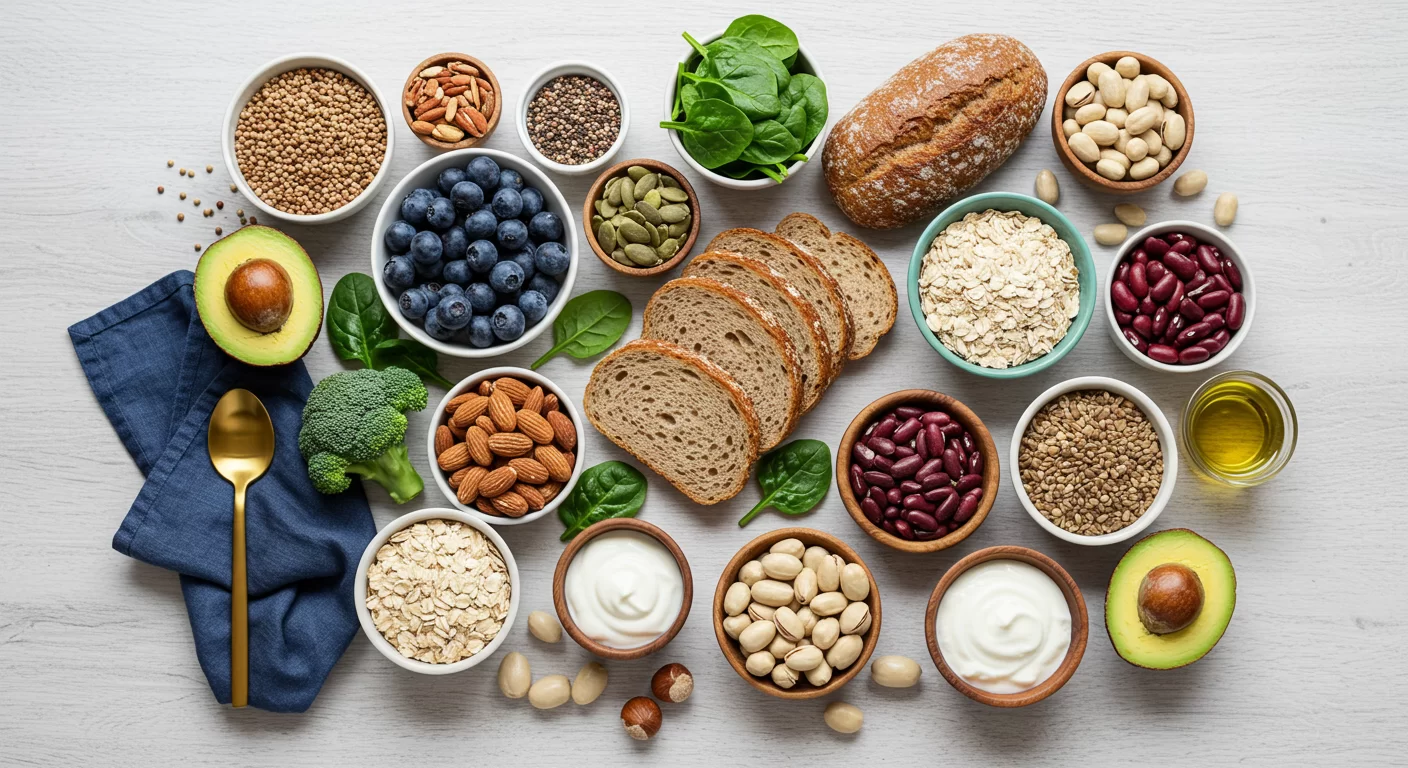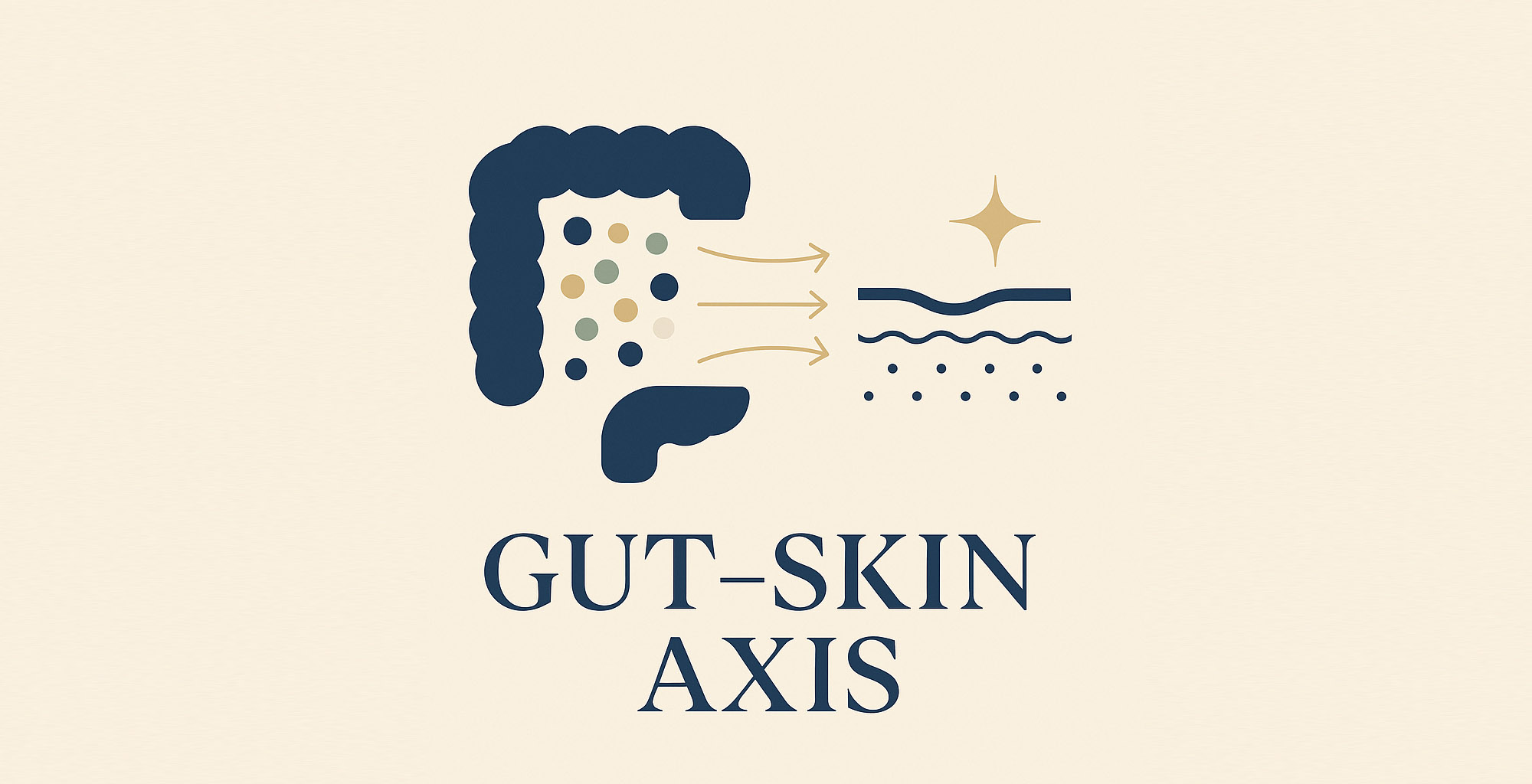Feeling sluggish, experiencing digestive discomfort, or noticing skin issues? The root cause might be in your gut. Short-chain fatty acids (SCFAs), produced by beneficial bacteria in your colon, are essential for a healthy gut microbiome and a strong gut barrier. This article explores the science-backed benefits of SCFAs, focusing on how they nourish your gut and contribute to overall well-being.
What are Short-Chain Fatty Acids (SCFAs)?
Short-chain fatty acids (SCFAs) are a group of organic acids produced in the colon when beneficial gut bacteria ferment dietary fibre – specifically, the types of fibre that your body can’t digest on its own. Think of them as a beneficial byproduct of this fermentation process, a reward for feeding your gut bacteria the right foods.
SCFAs are more than just a byproduct; they’re key players in gut health. They serve as a primary fuel source for the cells lining your colon (colonocytes), helping to keep them healthy and functioning properly. They also influence the balance of your gut microbiome and have potent anti-inflammatory effects.
Short-Chain Fatty Acid Production
SCFAs are primarily produced in the colon when gut bacteria ferment non-digestible carbohydrates (such as fiber). This fermentation process is vital for the gut microbiome, contributing to energy production, gut health, and overall well-being. SCFA production is influenced by the type of fiber consumed, with prebiotic-rich foods, such as garlic, onions, and bananas help foster the growth of SCFA-producing bacteria in the gut.
The Major Players: Acetate, Propionate, and Butyrate
SCFAs aren’t a single entity; they’re a group of several different fatty acids, each with slightly different roles. The three most abundant and well-studied SCFAs are
- Acetate or Acetic Acid: The most abundant SCFA, acetate helps regulate pH in the colon and acts as a substrate for cholesterol and lipid synthesis.
- Propionate or Propionic Acid: Propionate is primarily absorbed by the liver and plays a role in regulating glucose production and fat metabolism.
- Butyrate or Butyric Acid: While present in smaller amounts than acetate, butyrate is particularly important for gut health. It's the primary energy source for the cells lining your colon (colonocytes) and has potent anti-inflammatory effects.
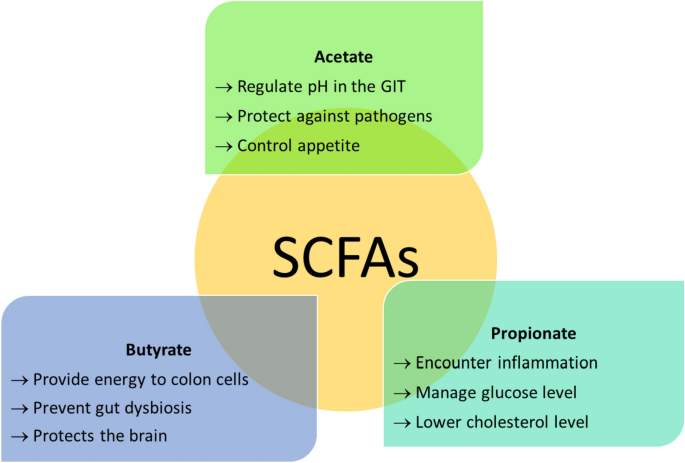
How SCFAs Shape the Microbiome and Reduce Inflammation
SCFAs play a crucial, multifaceted role in maintaining a healthy gut environment, impacting everything from the integrity of your gut lining to the balance of your gut bacteria. This, in turn, has a significant impact on your overall health and well-being.
Fueling the Gut Lining
Butyrate, in particular, serves as a primary energy source for the cells lining the colon (colonocytes). By providing these cells with the fuel they need, butyrate helps maintain the health and integrity of the gut lining. A healthy gut lining is essential for proper nutrient absorption and preventing harmful substances from entering the bloodstream.
Supporting Intestinal Barrier Function
The intestinal barrier is a single layer of cells that separates the contents of your intestines from the rest of your body. This barrier is crucial for absorbing nutrients while preventing harmful substances (undigested food particles, bacteria, toxins) from entering the bloodstream. Tight junctions, specialized protein structures, hold these cells together, forming a selective barrier.
SCFAs, particularly butyrate, play a vital role in maintaining the integrity of these tight junctions, National Library of Medicine. When tight junctions are weakened, increased intestinal permeability can occur. This is sometimes referred to as “leaky gut” in popular media, although it’s not a formal medical diagnosis. Increased intestinal permeability is associated with various health concerns, including inflammation and digestive issues. By supporting tight junction integrity, SCFAs help to maintain a healthy intestinal barrier and prevent unwanted substances from entering the bloodstream.
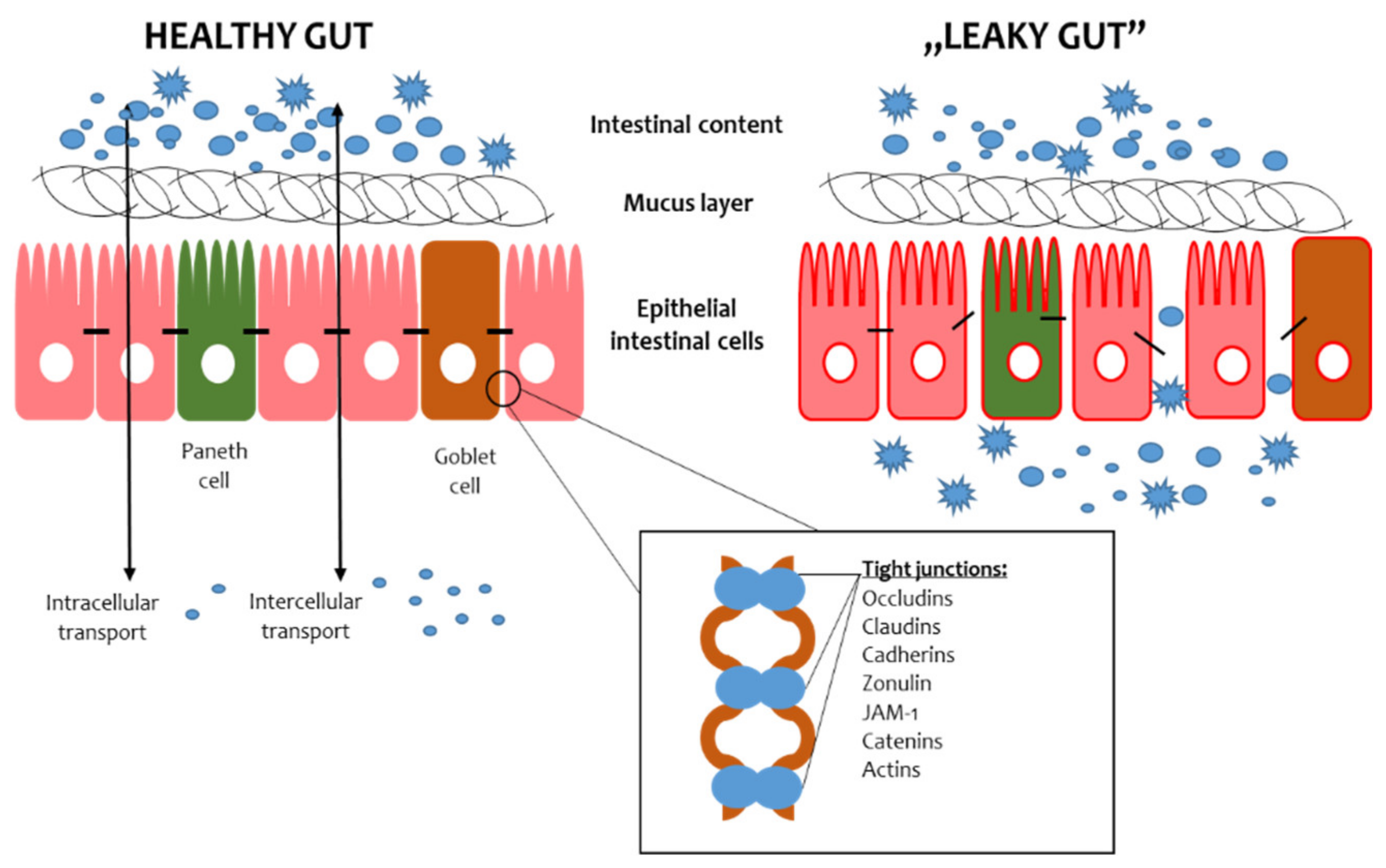
Modulating the Gut Microbiome
SCFAs influence the composition and function of the gut microbiome. They create an environment that favors the growth of beneficial bacteria while inhibiting the growth of harmful pathogens. This balance is crucial for optimal digestion, immune function, and overall health.
Anti-inflammatory Effects and Immune Balance
Chronic inflammation within the gut lining can disrupt the microbiome, compromise the gut barrier, and contribute to various digestive issues. SCFAs, particularly butyrate, exert powerful anti-inflammatory effects directly within the gut, helping to maintain a balanced and healthy environment. They do this primarily by influencing immune cell communication and function:
- Modulating Inflammatory Cytokines: Your immune system uses protein messengers called cytokines to coordinate its response. Some cytokines promote inflammation (pro-inflammatory) to fight invaders, while others help to resolve it (anti-inflammatory). An imbalance, with too many pro-inflammatory signals, contributes to chronic gut issues. Key pro-inflammatory cytokines involved include TNF-α (Tumor Necrosis Factor-alpha), an early responder that calls other immune cells to action, and IL-6 (Interleukin-6), which is often triggered by TNF-α and plays a role in both acute and chronic inflammation. SCFAs, especially butyrate, can help restore balance by suppressing the production and activity of pro-inflammatory cytokines like TNF-α and IL-6 within the gut lining. Nutrients, Natural Library of Medicine.
- Supporting Immune Tolerance (Regulatory T Cells): Beyond just dampening inflammation, SCFAs are crucial for promoting immune tolerance – preventing the immune system from overreacting to harmless substances or the body's own tissues. They do this by supporting the development and function of Regulatory T cells (Tregs). Tregs are specialized immune cells that act like peacekeepers, helping to suppress excessive inflammatory responses. By promoting Tregs within the gut, SCFAs contribute significantly to maintaining immune balance and preventing inflammatory conditions. Nutrients, Natural Library of Medicine.
By regulating inflammatory signals and promoting immune tolerance directly within the gut, SCFAs create a calmer, healthier environment, supporting the integrity of the gut barrier and the overall function of the digestive system.
Dietary Ways to Support SCFA Production
Boosting your body’s production of beneficial short-chain fatty acids (SCFAs) starts with your diet. The key is providing the right types of dietary fibre to fuel the beneficial bacteria residing in your gut, which then ferment these fibres to create SCFAs.
Understanding Dietary Fibre Types (Soluble vs. Insoluble)
Dietary fibre, the indigestible part of plants, is broadly classified based on its ability to dissolve in water:
- Soluble Fibre: Dissolves in water to form a gel-like substance. It includes types like pectins and beta-glucans. Soluble fibres are generally well-fermented by gut bacteria.
- Insoluble Fibre: Does not dissolve in water and helps add bulk to stool. While less readily fermented than soluble fibre, it still contributes to gut health.
While both types are important for overall digestive health, it’s primarily the fermentable fibres (often, but not exclusively, soluble) that are most crucial for SCFA production.
Key Foods Rich in Prebiotic Fibres (Including Resistant Starch)
Resistant starches are a category of dietary fiber found in foods such as artichokes, avocados, and some whole grain products, act as prebiotics by resisting digestion in the small intestine and being fermented in the large intestine. This fermentation process further enhances the production of SCFAs, thereby positively impacting metabolic health.
To effectively increase SCFAs, focus on incorporating a diverse range of foods rich in various prebiotic fibres into your regular meals. Excellent sources include:
- Vegetables: Onions, garlic, leeks, asparagus, Jerusalem artichokes, chicory root.
- Fruits: Slightly unripe bananas, apples (contain pectin), berries.
- Legumes: Lentils, beans (kidney, black, navy), chickpeas (contain GOS and resistant starch).
- Whole Grains: Oats and barley (contain beta-glucans and resistant starch).
- Nuts and Seeds: Flaxseeds, almonds.
- Cooked and Cooled Starches: Potatoes and rice that have been cooked and then cooled develop higher levels of resistant starch.
Aim for variety in your diet, as different prebiotic fibres feed different types of beneficial bacteria, contributing to a more diverse and resilient gut microbiome. Fiber and Prebiotics: Mechanisms and Health Benefits.
Health Benefits of Prebiotic Fibres (Including Resistant Starch)
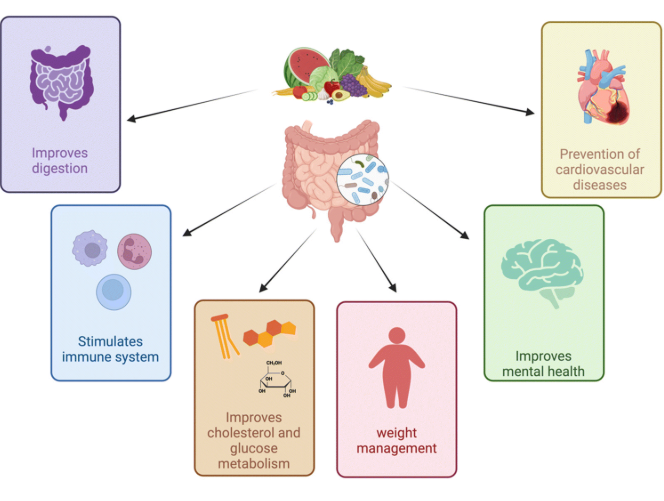
How Can You Support Your SCFAs Production?
Short-chain fatty acids are essential for a thriving gut microbiome and a strong gut barrier. By prioritizing a diet rich in diverse fibres, including resistant starch, you can nourish your gut bacteria and unlock the numerous health benefits of SCFAs. A healthy gut, fueled by SCFAs, is a cornerstone of overall well-being. To learn more about the impact of SCFAs on metabolic health, see Part 2: SCFAs and Metabolism: How Gut Fermentation Fuels Energy, Balance, and Fat Burning.
Guan, L. L., de Bruijn, W. J., Choong, Y. S., & Solis, G. (2019). Fermented Rice Bran and Rice Bran Oil in Traditional Japanese Medicine: Sake as a Potential Functional Beverage. Journal of Ethnopharmacology, 235, 405-418. https://doi.org/10.1016/j.jep.2019.01.007
Lee, D. E., Huh, C. S., & Huh, J. W. (2019). Korean Traditional Use of Fermented Rice Water: A Historical Review and its Modern Applications in Cosmetics. Journal of Cosmetic Science, 70(3), 241-250.
Zhou, J., & Qu, F. (2015). Face Mapping: Chinese Holistic Skin Analysis as an Indicator of Internal Organ Imbalance. International Journal of Dermatology, 54(8), 884-892. https://doi.org/10.1111/ijd.12736
Bowe, W. P., & Logan, A. C. (2011). Acne vulgaris, probiotics and the gut-brain-skin axis – Back to the future? Gut Pathogens, 3(1), 1. https://doi.org/10.1186/1757-4749-3-1
https://www.ncbi.nlm.nih.gov/pmc/articles/PMC10385652
https://www.mdpi.com/1422-0067/24/24/17618
https://journals.plos.org/plosone/article?id=10.1371/journal.pone.0237207
Join Us in Redefining Beauty
Subscribe for Exclusive Insights

